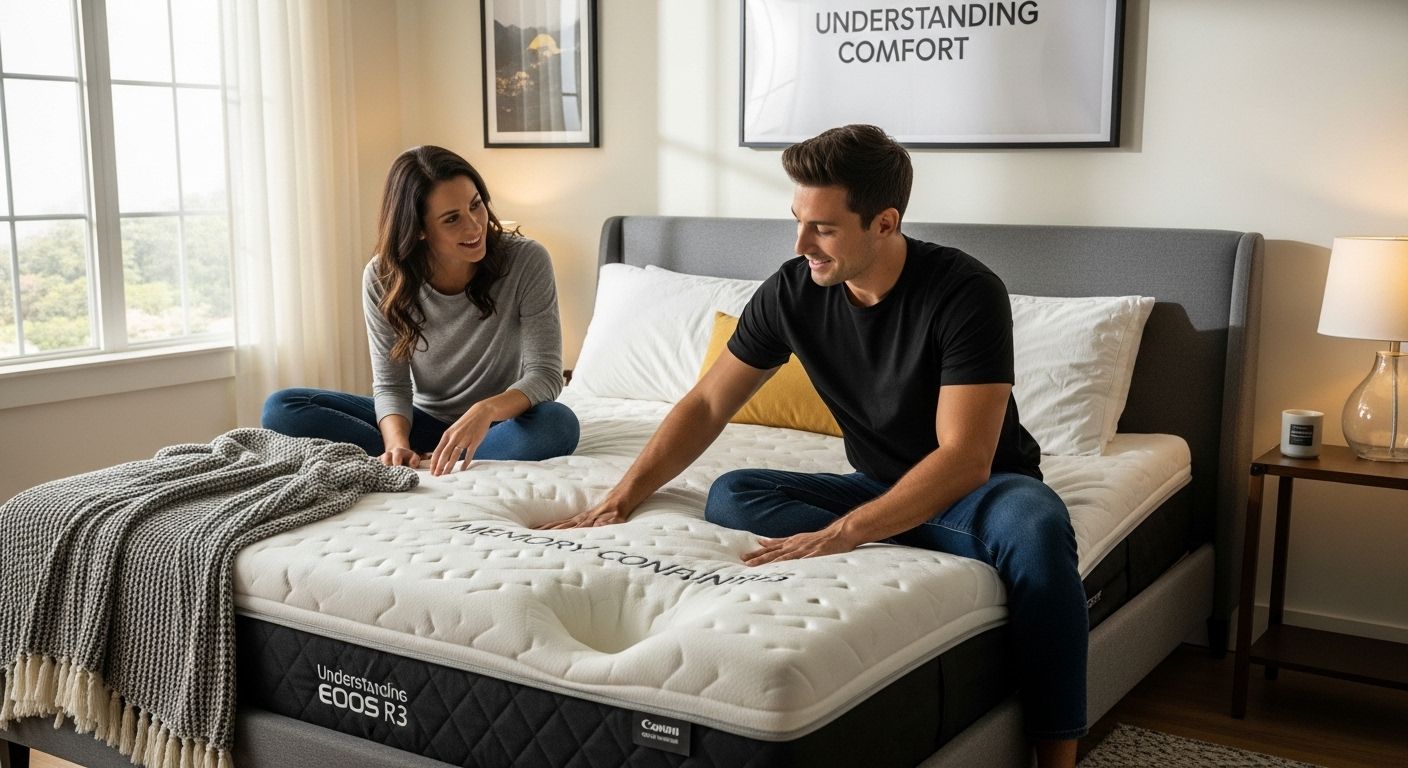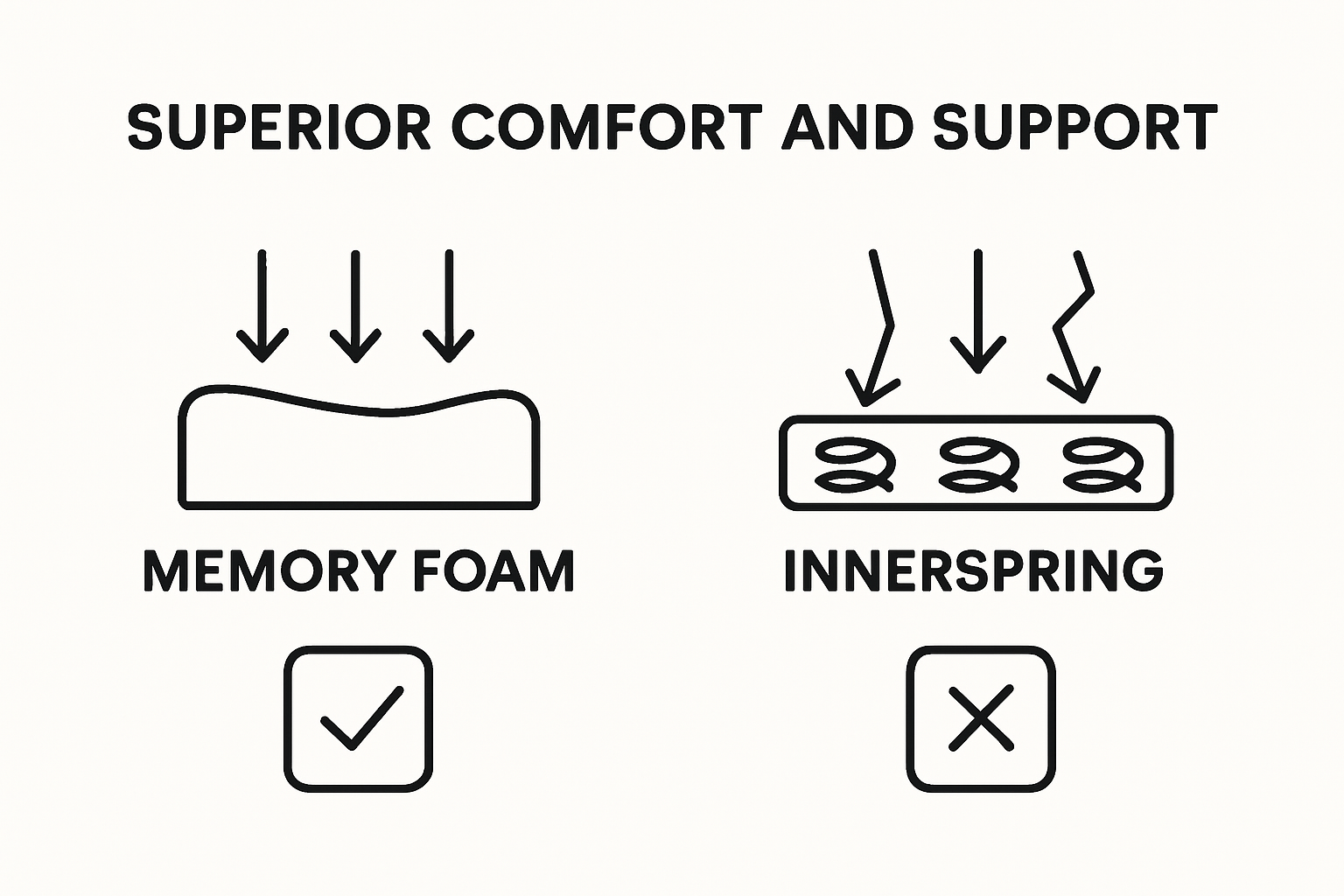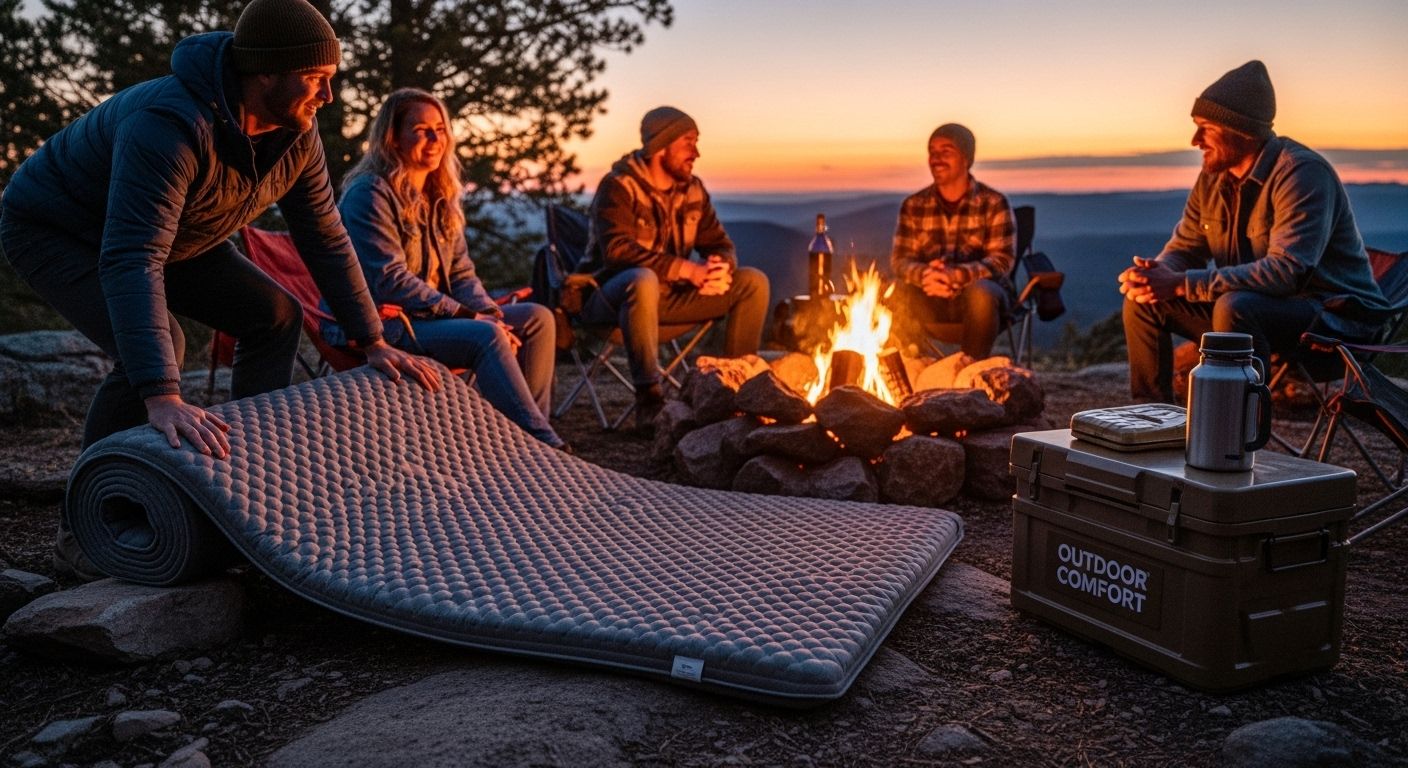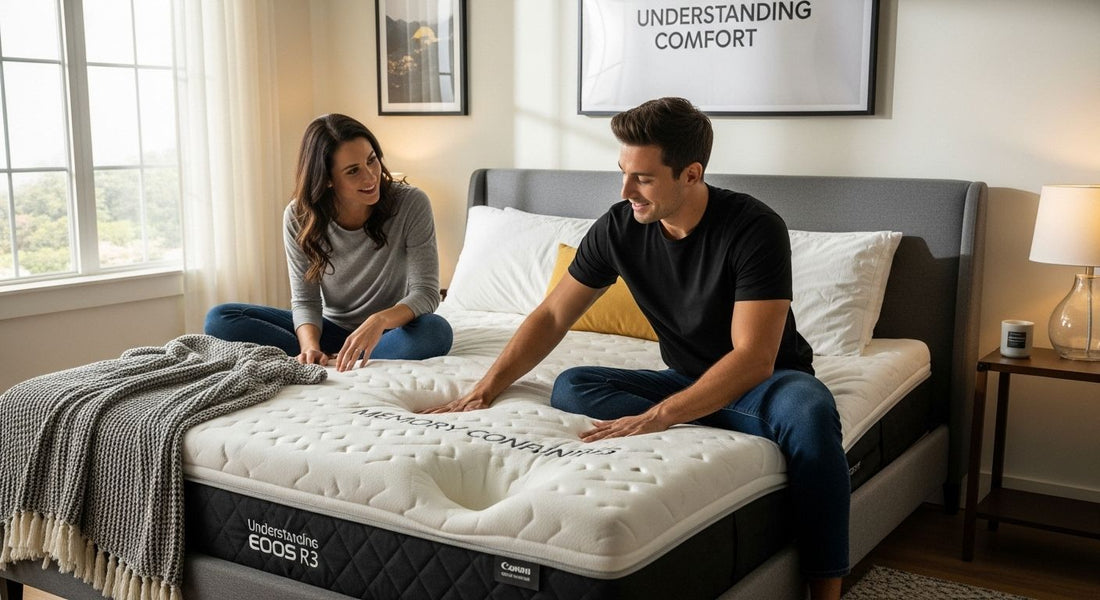
Memory foam mattresses changed the way people think about sleep comfort. Most folks know they adapt to your body, but few realize this technology was first created by NASA back in the 1960s. The real surprise is that memory foam can cut tissue compressive stresses by up to 67 percent compared to traditional mattresses. That means you are not just getting extra comfort—you could be protecting your body far more than you ever imagined.
Table of Contents
- What Are Memory Foam Mattresses And Their Unique Features?
- The Benefits Of Memory Foam For Outdoor Comfort And Sleep Quality
- How Memory Foam Works: The Science Behind Support And Pressure Relief
- Why Memory Foam Matters For Adventure Travelers And Campers
- Comparing Memory Foam With Other Mattress Types For Outdoor Use
Quick Summary
| Takeaway | Explanation |
|---|---|
| Memory foam adapts to body shapes | The unique viscoelastic property allows the mattress to contour and provide customized support for every user. |
| Excellent for reducing pressure points | Memory foam distributes body weight evenly, minimizing strain on joints and enhancing spinal alignment for better sleep quality. |
| Ideal for outdoor use and comfort | Its adaptability makes memory foam mattresses suitable for diverse terrains, providing consistent comfort during camping and hiking. |
| Durable and portable for travel | Lightweight and easily compressible, memory foam mattresses maintain their integrity over time, making them reliable for adventure and travel. |
| Promotes recovery from physical activities | The support and comfort provided by memory foam mattresses help alleviate muscle soreness, facilitating faster recovery after outdoor adventures. |
What Are Memory Foam Mattresses and Their Unique Features?
Memory foam mattresses represent a revolutionary sleeping technology that transforms how people experience comfort and support during rest. Originally developed by NASA in the 1960s, this specialized material has transitioned from aerospace applications to becoming a game changing solution in the bedding industry.
The Science Behind Memory Foam
At its core, memory foam is a viscoelastic polyurethane material engineered to respond dynamically to body heat and pressure. When you lie down, the foam molecules begin to soften and reshape, creating a personalized sleeping surface that precisely contours to your body’s unique curves. According to Sleep Foundation, this adaptive property allows the mattress to distribute weight evenly, reducing pressure points and promoting better spinal alignment.
Key Characteristics of Memory Foam
Memory foam mattresses offer several distinctive features that set them apart from traditional sleeping surfaces:
- Pressure Point Relief: Strategically distributes body weight to minimize stress on joints
- Motion Isolation: Absorbs movement, preventing disturbances when your partner shifts or moves
- Temperature Sensitivity: Softens and molds according to body heat for personalized comfort
Unlike traditional innerspring mattresses, memory foam provides a more responsive and supportive sleeping experience. The material’s ability to adapt to individual body shapes means each person receives customized support, making these mattresses particularly beneficial for those with chronic pain or those seeking enhanced sleep quality.
By understanding the unique engineering behind memory foam, consumers can make informed decisions about their sleep environment and invest in a mattress that truly supports their physical needs.
The Benefits of Memory Foam for Outdoor Comfort and Sleep Quality
Outdoor enthusiasts and adventure travelers understand that quality sleep is crucial for peak performance and enjoyment during any expedition. Memory foam mattresses offer remarkable advantages that transform sleeping experiences in challenging outdoor environments, providing unparalleled comfort and support where traditional mattresses fall short.
Enhanced Physical Recovery and Support
Memory foam delivers exceptional benefits for outdoor adventurers by promoting optimal body alignment and reducing physical strain. According to Clinical Biomechanics Research, medium-firm memory foam mattresses can significantly improve spinal support and reduce muscular discomfort. This makes them ideal for individuals returning from physically demanding activities like hiking, camping, or mountain climbing.
Adaptability to Varied Terrain and Conditions
One of the most significant advantages of memory foam in outdoor settings is its remarkable adaptability. The material’s unique viscoelastic properties allow it to:
- Temperature Regulation: Adjust to different environmental temperatures
- Pressure Distribution: Provide consistent support on uneven surfaces
- Compact Compression: Easily fold and transport without losing structural integrity
These characteristics make memory foam mattresses particularly valuable for camping, backpacking, and other outdoor adventures where sleeping conditions can be unpredictable and challenging.
Long-Term Comfort and Durability
Outdoor enthusiasts require gear that withstands rigorous conditions while maintaining performance. Memory foam mattresses excel in this domain, offering durability and consistent comfort across multiple expeditions. Their ability to return to original shape after compression ensures long-lasting support, making them a reliable investment for frequent travelers and outdoor professionals seeking dependable sleeping solutions.
How Memory Foam Works: The Science Behind Support and Pressure Relief
Memory foam represents a sophisticated technological innovation that goes far beyond traditional mattress materials, utilizing advanced molecular engineering to create a sleep surface that adapts and responds to the human body. Understanding its intricate mechanism reveals why this material has revolutionized comfort and support in sleep technology.
Molecular Responsiveness and Heat Activation
At the microscopic level, memory foam contains polyurethane molecules with unique viscoelastic properties that enable extraordinary responsiveness. When body heat is applied, these molecules begin to soften and reshape, creating a dynamic sleeping surface that precisely contours to an individual’s physical shape. According to Clinical Biomechanics Research, this mechanism allows for a 67% reduction in tissue compressive stresses compared to traditional mattress materials.
Pressure Distribution Mechanism
The core functionality of memory foam centers on its ability to distribute body weight uniformly, which provides critical benefits for physical recovery and comfort:
- Weight Redistribution: Eliminates concentrated pressure points
- Spinal Alignment: Promotes natural curvature of the spine
- Cellular Compression: Gradual and proportional response to body weight
This intelligent design means the mattress does not simply support your body but actively responds to its unique contours, creating a personalized sleeping environment that adapts in real time.
Thermal and Mechanical Intelligence
Memory foam’s sophisticated design incorporates both thermal and mechanical intelligence. The material’s molecules are engineered to become more fluid with increased temperature, allowing them to move and reshape more readily. This means the mattress becomes softer and more responsive as it absorbs body heat, creating a seamless, dynamic sleeping experience that adjusts continuously to provide optimal comfort and support.
Why Memory Foam Matters for Adventure Travelers and Campers
For adventure travelers and outdoor enthusiasts, sleep is not just a necessity but a critical component of performance and enjoyment. Memory foam emerges as a game changing solution that addresses the unique challenges of sleeping in diverse and often unpredictable outdoor environments.
Adaptability in Challenging Terrain
Traditional sleeping surfaces fall short when confronted with the varied landscapes encountered during outdoor adventures. Memory foam’s exceptional adaptability sets it apart, providing consistent comfort across different terrains and conditions. According to Sleep Research Journal, memory foam’s viscoelastic properties can dramatically improve pressure distribution, transforming potentially uncomfortable sleeping situations into restorative rest experiences.
Performance Benefits for Outdoor Enthusiasts
Memory foam offers several critical advantages that make it indispensable for adventure travelers:
- Compact Portability: Lightweight and easily compressible for transportation
- Quick Recovery: Rapidly returns to original shape after compression
- Temperature Adaptation: Maintains comfort across varying environmental conditions
These characteristics ensure that travelers can maintain high performance levels by getting quality rest, regardless of their sleeping environment. The material’s ability to conform to uneven surfaces means you can create a comfortable sleeping space in locations where traditional mattresses would be impractical.
Recovery and Injury Prevention
Outdoor activities often place significant physical stress on the body. Memory foam’s unique design provides critical support during recovery, helping to alleviate muscle soreness and reduce the risk of strain. By distributing body weight evenly and supporting natural spinal alignment, memory foam transforms sleeping from a passive recovery process into an active regeneration strategy for adventure enthusiasts.
Comparing Memory Foam with Other Mattress Types for Outdoor Use
Selecting the right mattress for outdoor adventures requires understanding how different materials perform in challenging environments. While multiple mattress types exist, memory foam stands out as a superior option for travelers seeking comfort, portability, and adaptability.

Performance Characteristics
Each mattress type brings unique qualities to outdoor sleeping scenarios. Innerspring mattresses, traditionally popular, offer bouncy support but struggle with weight distribution and portability. Air mattresses provide lightweight options but frequently compromise on long-term comfort and durability. According to MADE SAFE Organization, synthetic mattress materials can also present environmental and health concerns that outdoor enthusiasts should carefully consider.
Comparative Advantages of Memory Foam
Memory foam demonstrates significant advantages for outdoor use across several critical dimensions:
- Weight Distribution: Superior pressure point reduction
- Compactness: Easily compressed and transported
- Durability: Maintains structural integrity across multiple uses
- Adaptability: Conforms to varied terrain and temperature conditions
These characteristics make memory foam particularly effective for camping, backpacking, and adventure travel, where traditional mattress solutions often fall short of meeting complex environmental demands.
Practical Considerations for Outdoor Sleeping
Choosing a mattress involves balancing multiple factors beyond immediate comfort. Memory foam’s ability to provide consistent support across uneven surfaces gives it a distinct edge for outdoor applications. Its molecular structure allows for rapid shape recovery, meaning the mattress maintains its supportive properties even after being compressed in a backpack or exposed to varying environmental conditions. This resilience translates directly into improved sleep quality and physical recovery for adventure travelers.
The following table compares the key features, advantages, and drawbacks of the three main types of mattresses mentioned for outdoor use: memory foam, innerspring, and air mattresses.
| Mattress Type | Key Features | Advantages | Drawbacks |
|---|---|---|---|
| Memory Foam | Viscoelastic, adapts to body heat & pressure | Superior pressure relief, excellent support, portable | Can retain heat in warm conditions |
| Innerspring | Steel coils, bouncy support | Good responsiveness, familiar feel | Poor weight distribution, less portable, less durable |
| Air Mattress | Inflatable chambers, adjustable firmness | Lightweight, adjustable firmness | Prone to leaks, less durable, inconsistent support |

Experience Restful Comfort Anywhere with Hazli Collection
If you have ever struggled to sleep well while camping or traveling outdoors, you know how frustrating it is to wake up tired and sore. The article discussed how memory foam mattresses adapt to your body, relieve pressure points, and make rest possible even on rough ground. Many outdoor enthusiasts find traditional sleeping options uncomfortable and difficult to carry, which can leave you worn out instead of refreshed for your next adventure.

You do not have to settle for restless nights. Hazli Collection offers high-quality memory foam mattresses designed specifically for outdoor comfort, giving you the support and recovery you deserve wherever you set up camp. Our products help you enjoy the benefits of advanced memory foam technology, just like described in the article. Shop now at Hazli Collection to discover sleep solutions that will keep you energized for every journey. Do not let another trip end with sleepless nights. Find your ideal outdoor mattress today so you can rest easy no matter where you go.
Frequently Asked Questions
What are memory foam mattresses made of?
Memory foam mattresses are primarily made of viscoelastic polyurethane foam, which is engineered to respond to body heat and pressure for a customized sleeping experience.
How does memory foam relieve pressure points?
Memory foam relieves pressure points by evenly distributing body weight across the sleeping surface, which minimizes stress on joints and promotes better spinal alignment.
Are memory foam mattresses suitable for outdoor use?
Yes, memory foam mattresses are suitable for outdoor use due to their adaptability to various terrains, temperature regulation, and comfort enhancement, making them ideal for camping and adventure travel.
How do memory foam mattresses compare to innerspring mattresses?
Memory foam mattresses differ from innerspring mattresses in that they provide superior pressure relief and motion isolation, whereas innerspring mattresses often offer more bounce and responsiveness but lack personalized support.

